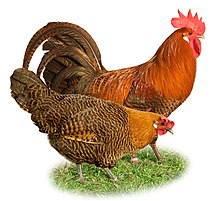Braekel
This article needs additional citations for verification. (August 2017) |
 | |
| Other names | Brakel |
|---|---|
| Country of origin | Belgium |
| Use | eggs |
| Traits | |
| Weight | |
| Egg colour | white[2] |
| Classification | |
| APA | not listed[3] |
| PCGB | rare soft feather: light[4] |
| |
The Braekel or Brakel is one of the older European chicken breeds. Its history dates back to 1416, when it was mentioned as a successful poultry breed of the Brakel region of Belgium.[5] There is a bantam version of the Braekel.[6]
History
Two distinct types of Braekel were recognized in the past: the large type living on rich clay soil Flanders, and a light-weight type from the less fertile region, the Kempen. Due to crossbreeding between the different types, this distinction vanished, resulting in a single type.
In the UK, USA and Australia, however, one can still find descendants of the Kempische Brakel under its old name 'Campine'. The Campine has evolved differently from the Braekel. The most noticeable difference is the hen-feathering of the rooster and the lower weight.
The Braekel population declined during and after the Second World War and it is a rare breed.
Characteristics
The Braekel is a light breed; cocks weigh 2–2.5 kg and hens 1.8–2.2 kg.[1] Bantam cocks weigh about 800 g and hens about 700 g.[6] Ring sizes are 18 mm and 16 mm for standard-sized cocks and hens, and 13 mm and 11 mm respectively for bantams.[6]
A straight banding pattern of the feathers and a uniform solid neck colour are characteristic of the Braekel. Several colour variants exist, with the gold and the silver variant being the most common.
Use
The Braekel is not cultivated for its meat, but merely for its egg-laying qualities. The breed is capable of producing 180 to 200 white eggs a year.
References
- ^ a b c Het Brakelhoen (in Dutch). Lierde: Braekelclub-Nederbraekel. Accessed August 2014.
- ^ Victoria Roberts (2008). British poultry standards: complete specifications and judging points of all standardized breeds and varieties of poultry as compiled by the specialist breed clubs and recognised by the Poultry Club of Great Britain. Oxford: Blackwell. ISBN 9781405156424. p. 84.
- ^ APA Recognized Breeds and Varieties: As of January 1, 2012. American Poultry Association. Archived 4 November 2017.
- ^ Breed Classification. Poultry Club of Great Britain. Accessed August 2014.
- ^ N. Moula, M. Jacquet, A. Verelst, N. Antoine-Moussiaux, F. Farnir, P. Leroy (2012). Les races de poules belges (in French). Annales de Médecine Vétérinaire 156: 37-65. Accessed August 2014.
- ^ a b c Raskenmerken: De kenmerken van het brakelhoen (in Dutch). Brakelhoenspeciaalclub, 2011. Archived 29 May 2013.
![]() Media related to Braekel at Wikimedia Commons
Media related to Braekel at Wikimedia Commons
